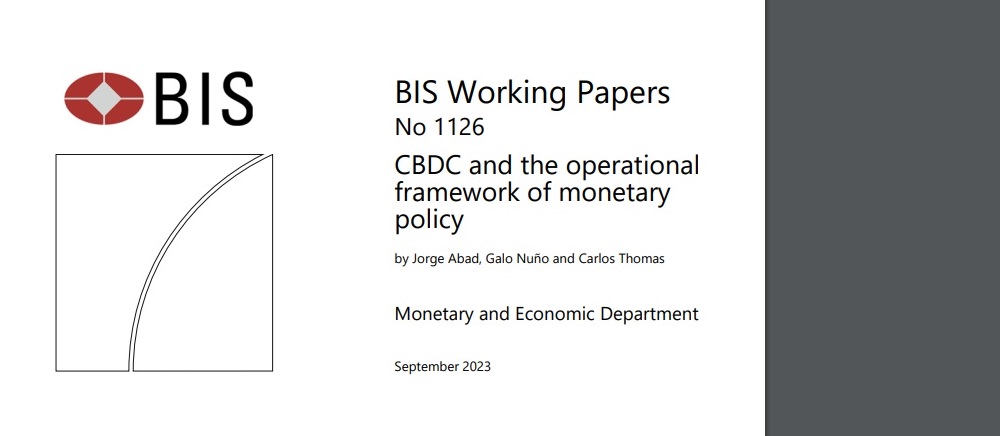BIS white paper: „CBDC adoption implies a roughly equivalent reduction in banks’ deposit funding”

For CBCD adoption levels exceeding 10% of GDP, there are no reserves left to absorb the contraction in bank deposits. However, this ‘deposit crunch’ has a rather small effect on bank lending to the real economy.
What effect would a retail central bank digital currency (CBDC) have on monetary policy implementation in the euro area, and how would this shape the macroeconomic effects of a CBDC? The introduction of a CBDC could affect the operational framework of monetary policy and the conditions in interbank markets if it brings about a sufficiently large decrease in excess reserves due to the reduction in bank deposits. This, in turn, could have important macroeconomic implications, both in the long run and during the CBDC adoption phase.
The authors of the white paper called CBDC and the operational framework of monetary policy, analyzed the impact of introducing a central bank-issued digital currency (CBDC) on the operational framework of monetary policy and the macroeconomy as a whole. To this end, they developed a New Keynesian model with heterogeneous banks, a frictional interbank market, a central bank with deposit and lending facillities, and household preferences for different liquid assets. The model is calibrated to replicate the main monetary and financial aggregates in the euro area.
We replicate the balance sheet of the Eurosystem and of the consolidated commercial banking sector. The core of our analysis is on the long-run effects of introducing non-remunerated CBDC. In particular, we perform a comparative statics exercise in which we vary households’ preferences for CBDC, effectively comparing steady states with a different equilibrium demand for this currency.
Our analysis predicts that households’ demand for non-CBDC liquidity (bank deposits plus cash) falls essentially one-for-one with CBDC demand, but the bulk of the adjustment (about three quarters) falls on bank deposits. Therefore, relatively large levels of CBDC adoption come hand in hand with a ‘deposit crunch’ on the banking sector.
However, the latter does not imply a ‘credit crunch’: even large reductions in deposit funding have rather small effects on bank lending to firms, and therefore on productive investment and GDP. For instance, a level of CBDC adoption equivalent to 20% of GDP reduces bank deposits by 15% of GDP, but this lowers productive capital by less than 1% and GDP by barely 0.3%. At the core of the above result lies the impact that CBDC has in parallel on the central bank’s monetary policy operational framework.
Our initial (no CBDC) steady state is consistent with the ‘floor system’ currently implemented by most central banks in advanced economies, characterized by an ample supply of central bank reserves and interbank rates pushed against the remuneration of reserve deposits.
For long-run levels of CBDC adoption below 9% of GDP, the reduction in bank deposits is essentially
absorbed by an almost one-for-one fall in reserve balances at the central bank. This allows the banking sector to preserve most of its lending to the real economy despite the ‘deposit crunch’. For that range of CBDC demand, the floor system is preserved.
As CBDC adoption nears 10% of GDP, the floor system is replaced by a ‘corridor system’, characterized by balanced lending and borrowing activity in the interbank market, a low level of central bank reserves, and interbank market rates around the midpoint of the interest rate corridor. For CBCD adoption levels exceeding 10% of GDP, there are no reserves left to absorb the contraction in bank deposits. Instead, banks replace the lost deposits –and thus continue to preserve most of their lending to firms– by increasing their recourse to the central bank’s credit facility. At those levels of CBDC demand, the corridor system gives way to a ‘ceiling’ system, characterized by scarce (in fact, zero) reserves and interbank rates pushed against the lending facility rate.
For more details:
BIS Working Papers No 1126 – CBDC and the operational framework of monetary policy
Dariusz Mazurkiewicz – CEO at BLIK Polish Payment Standard
Banking 4.0 – „how was the experience for you”
„To be honest I think that Sinaia, your conference, is much better then Davos.”
Many more interesting quotes in the video below:












